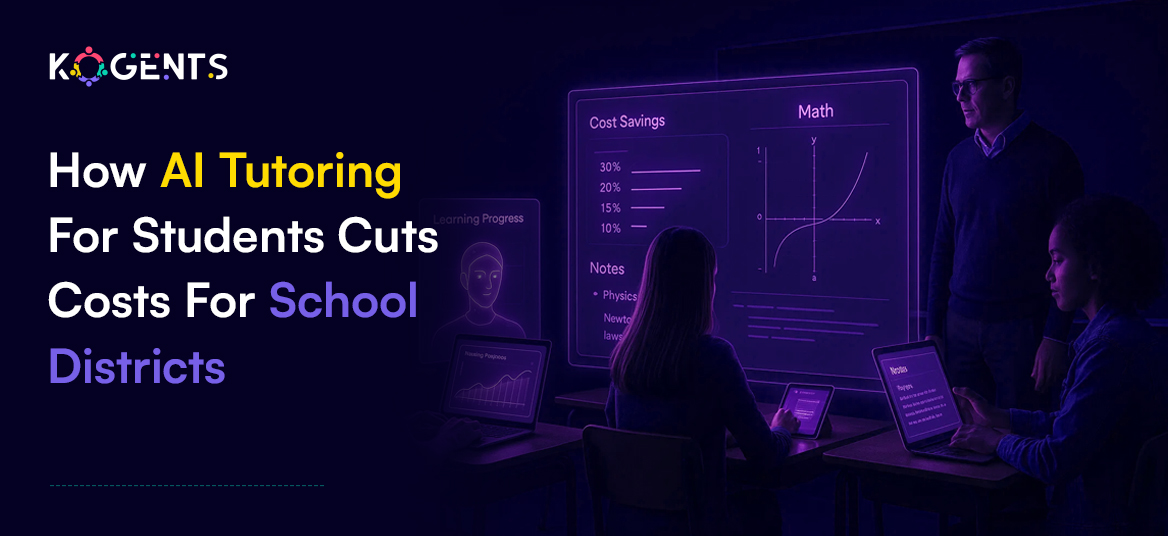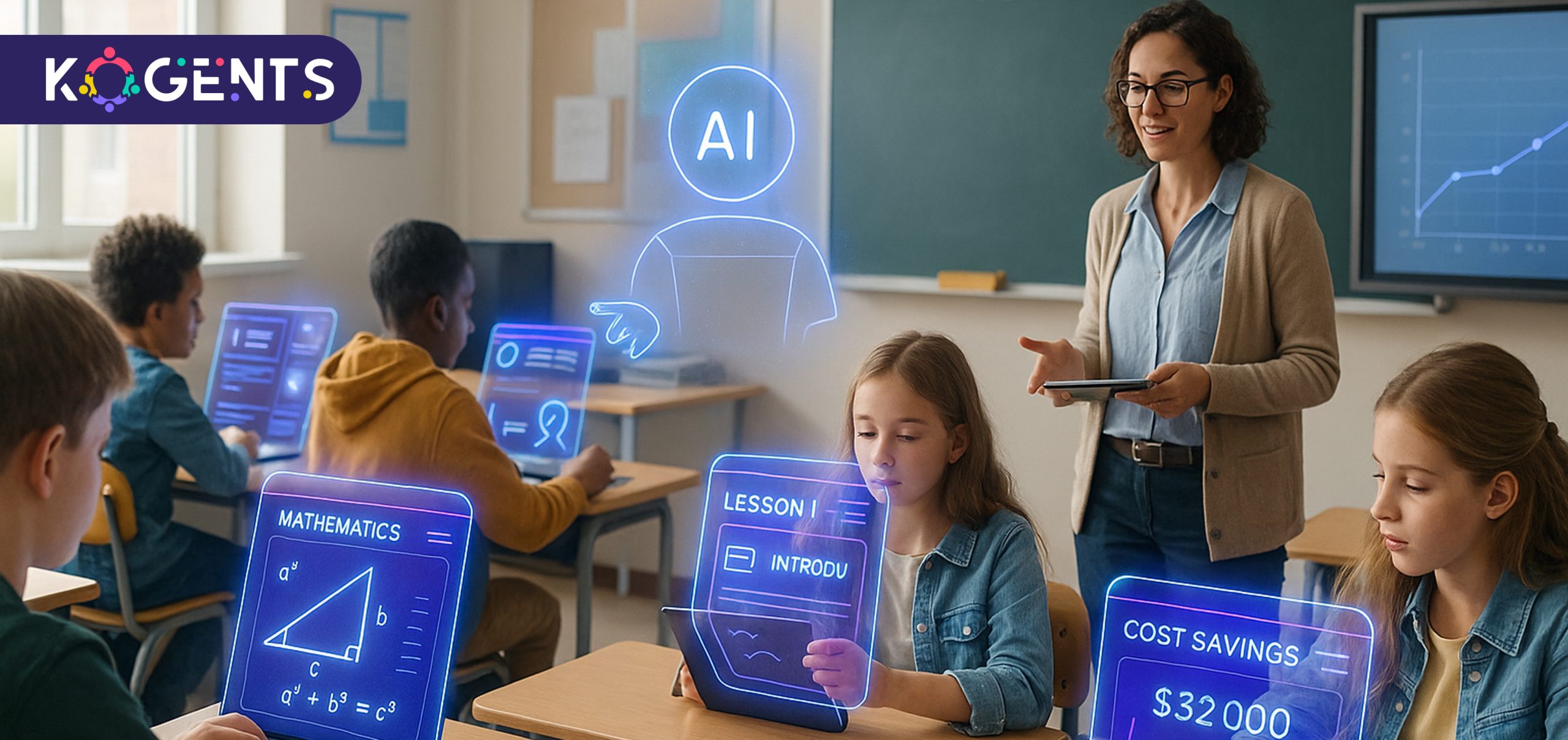How AI Tutoring for Students Cuts Costs for School Districts

Summary:
Do you know that school districts worldwide are under immense trouble and pressure? Due to the shrinking budgets, rising costs, and teacher shortages, teachers are being stretched to the limit.
On the contrary, traditional tutoring may help, but it’s expensive, hard to scale, and leaves too many students behind.
The question is no longer if schools should adopt AI tutoring systems, but how fast they can integrate them to save money while driving better results.
This is why many districts are now turning to AI tutoring for students, a groundbreaking innovation in educational technology (EdTech) that is transforming how academic support is delivered.
At its core, AI tutoring for students leverages intelligent tutoring systems (ITS), adaptive AI learning assistants, and AI-powered tutoring platforms to provide scalable, personalized learning experiences.
Unlike generic digital learning assistants or static online resources, these tools use natural language processing, tutoring, and learning analytics in education to give students instant feedback, tailor lessons to their progress, and improve student academic performance at a fraction of the cost of human tutoring.
Districts that adopt AI academic support tools gain more than savings; they unlock equity.
Every student, regardless of background, can access a personalized AI tutor app or virtual AI tutor for learning, leveling the playing field across classrooms.
What Is AI Tutoring for Students?
It is the use of artificial intelligence systems to deliver one-on-one or group learning experiences in a digital environment.
Unlike generic EdTech tools that provide static content, AI tutors or an AI agent for education adapt in real time to each student’s strengths and weaknesses.
Key concepts include:
- Virtual AI Tutor for Learning: Chatbot-style assistants that answer questions and guide students through exercises.
- AI-Powered Tutoring Platforms: Comprehensive apps that deliver lessons, quizzes, and practice exercises tailored to each student.
- Intelligent Tutoring Systems (ITS): AI programs that mimic human tutors, offering hints, explanations, and scaffolding.
- Personalized AI Tutor Apps: Mobile and web-based apps that provide continuous learning support beyond the classroom.
Why Do School Districts Need AI Tutoring Agents?
1. Rising Costs of Traditional Tutoring
- Hiring human tutors is costly, ranging from $50 to $100 per hour per student.
- When scaled to hundreds or thousands of students, these costs are simply unsustainable for most districts.
2. Teacher Shortages
- Across the U.S. and many other countries, schools are facing teacher and tutor shortages.
- Even when budgets allow for additional tutoring, there often aren’t enough qualified educators to fill the roles.
3. Demand for Personalized Learning
- Students learn at different paces, yet traditional classrooms often take a one-size-fits-all approach.
- Parents and educators are increasingly demanding individualized support, which AI tutors provide affordably at scale.
How AI Tutoring Systems Work?
AI tutoring systems use advanced technologies to deliver customized academic support:
- Natural Language Processing (NLP): Enables AI tutors to understand student questions in plain language.
- Adaptive AI Learning Assistant: Adjusts content difficulty based on student performance.
- Smart Tutoring Systems: Mimic real human tutors by giving hints, explanations, and practice exercises.
- AI-Powered Assessments: Provide instant grading and insights into learning gaps.
Example: intelligent tutoring systems in education can track student behavior (time spent per problem, incorrect answers, etc.) and generate personalized AI tutor app recommendations.
Core Features of AI-Powered Tutoring Platforms
Modern AI tutoring platforms come equipped with advanced features designed to maximize student learning and minimize costs for districts:
1. Real-Time Feedback
Students receive instant corrections and hints.
Unlike delayed grading, AI ensures errors are addressed immediately, preventing misconceptions from solidifying.
2. Personalized Learning Paths
Each student follows a unique journey.
AI analyzes past performance and adjusts the curriculum in real time, ensuring lessons are neither too easy nor too hard.
3. Intelligent Questioning & Socratic Dialogue
Some AI tutors engage students with guided questions rather than giving direct answers, fostering critical thinking skills rather than rote memorization.
4. AI-Powered Assessments
Quizzes, assignments, and tests are auto-graded. AI not only marks right or wrong but also explains errors, providing students with actionable learning insights.
5. Learning Analytics Dashboards
Teachers and administrators access data-rich dashboards that highlight patterns in student performance, enabling targeted interventions.
6. Accessibility & 24/7 Availability
AI tutors are device-friendly and available anytime, offering consistent academic support far beyond classroom hours.
Together, these features transform AI tutors from simple study tools into full-fledged intelligent tutoring ecosystems.

Key Advantages of AI Tutoring for School Districts
The benefits of AI tutoring extend across cost savings, learning outcomes, and systemic equity:
1. Dramatic Cost Reduction
Traditional tutoring programs are financially draining.
AI reduces costs by up to 80% through affordable subscriptions that scale across thousands of students.
2. Scalable Access
Unlike human tutors limited by schedules, AI can support an entire district simultaneously, ensuring no student is left behind.
3. Improved Academic Performance
Research shows students using AI tutors achieve 20–40% better performance on standardized assessments thanks to adaptive, personalized support.
4. Greater Educational Equity
AI ensures that underserved students, who often lack access to private tutors, receive the same level of academic help as wealthier peers.
5. Teacher Empowerment
Instead of replacing educators, AI assists them by:
- Reducing grading workloads.
- Highlighting students needing extra help.
- Providing real-time insights for lesson adjustments.
6. Flexibility for Students
Students learn at their own pace, revisit concepts on demand, and access AI tutors anytime, anywhere.
By delivering these benefits, AI tutoring becomes both an economic necessity and an educational innovation.
Use Cases in Education
AI tutoring is not a futuristic concept anymore; it’s actively reshaping how students learn. Let’s look at some practical use cases inside school districts:
- Homework AI Chatbot: Students can get AI homework help for math, science, and language arts through conversational tutoring bots.
- Online AI Tutoring Services: Districts can provide AI-powered support platforms to supplement classroom teaching.
- Personalized AI Tutor Apps: Each student can carry a digital learning assistant on their phone or tablet, offering 24/7 study help.
- Virtual AI Tutors for Learning: Language learners, for instance, benefit from Duolingo’s AI tutor that simulates real-life conversations.
- AI Academic Support Tools for Teachers: Educators use AI-powered assessments and learning analytics to spot at-risk students early.
Soft-Reminder: By integrating these systems, school districts give every student the individualized attention once reserved for expensive private tutoring.
Case Studies of AI Tutoring in Schools
1. Khan Academy & GPT-4 Integration
In 2023, Khan Academy partnered with OpenAI’s GPT-4 to launch Khanmigo, an AI tutor that engages students in Socratic-style dialogue.
- Teachers reported students were more engaged in math practice.
- The district saved thousands in supplemental tutoring costs by replacing external tutoring contracts.
2. Duolingo’s AI Tutor for Languages
Duolingo introduced AI-driven lessons that personalize challenges.
- Students showed 20% faster retention of new vocabulary.
- Districts could cut back on external ESL (English as a Second Language) tutors while providing scalable support.
3. Carnegie Learning
Carnegie’s intelligent tutoring system has been studied in multiple districts.
- Results show a 1.5x improvement in math test scores compared to traditional methods.
- Lowered reliance on costly after-school tutoring programs.
What Do You Get? These case studies highlight how AI tutoring systems cut costs while improving student learning outcomes.
Cost Savings Breakdown
| Tutoring Model | Cost per Student (Annual) | Scalability | Accessibility |
| Traditional Human Tutoring | $1,500–$3,000 | Limited | Budget-restricted |
| Online Human Tutors | $800–$1,200 | Moderate | Flexible but costly |
| AI Tutoring Platforms | $50–$200 | High | 24/7, scalable |
| Hybrid (AI + Teacher Oversight) | $300–$500 | Very High | Balanced |
Key Fun Fact: A district of 10,000 students could save millions annually by switching to AI tutoring.
Challenges & Limitations For AI Tutoring for Students
Despite its strengths, AI tutoring has challenges:
1. Data Privacy & Compliance
Districts must verify platforms comply with FERPA (US), GDPR (EU), and other local data protection regulations. Student data safety is non-negotiable.
2. Teacher & Parent Acceptance and Concerns
Some teachers fear being replaced, while some parents worry about “robots teaching their kids.” Training and transparent communication are crucial for adoption.
3. Equity of Access
Without internet and device access, students risk being left behind. Districts must consider device-lending programs and subsidized internet access.
4. Over-Reliance on AI
AI tutors excel at structured learning but cannot provide emotional support or mentorship. A hybrid AI + teacher model ensures balance.
5. Accuracy & Bias
AI systems can sometimes provide inaccurate answers or biased responses. Continuous monitoring and vendor accountability are critical.
AI Tutoring vs Other EdTech Tools
| Feature | AI Tutoring | Traditional Tutoring | Generic EdTech Tools |
| Cost | Low | High | Medium |
| Personalization | High | High | Low |
| Availability | 24/7 | Limited | Always, but static |
| Scalability | Very High | Low | High |
| Feedback Speed | Instant | Delayed | None |
| Teacher Role | Supportive | Direct | Supplemental |
Future of AI Tutoring in Education
The future of AI tutoring looks even more transformative:
- AI-Driven Personalized Learning: Each student’s curriculum will be auto-adjusted daily.
- AR/VR Integration: Imagine virtual classrooms with AI tutors guiding students through 3D simulations.
- Learning Analytics Dashboards: District administrators will get predictive insights into student success rates.
- AI-Powered Assessments: Fully automated grading that reduces teacher workload.
Know It! Within the next decade, AI tutoring may become as common as textbooks in classrooms.

Why AI Tutoring for Students Is the Smartest Choice!
The future of education belongs to districts that embrace technology designed for efficiency and impact.
By integrating AI tutoring systems, students and administrators not only lower costs but also ensure that every student, regardless of background, has access to individualized learning support.
This shift strengthens teachers, elevates classrooms, and prepares schools for the demands of modern education.
Kogents AI adopts AI tutoring for students with scalable, compliant, and results-driven solutions.
to see how you can save money while unlocking better outcomes for every learner. Call us at (267) 248-9454. Today, or drop an email at info@portal.kogents.ai.
FAQs
How effective are AI tutors for improving grades?
Studies show AI tutors can improve student performance by 20–40% compared to traditional methods.
How much does AI tutoring cost for schools?
Typically $50–$200 per student annually, far cheaper than human tutoring.
Which are the best AI tutoring platforms in 2025?
Khan Academy (Khanmigo), Carnegie Learning, Duolingo AI tutor, and ChatGPT-powered tutoring services.
Is AI tutoring safe for students’ data?
Yes, reputable platforms comply with FERPA, GDPR, and ISO 21001 standards.
Will AI tutors replace teachers?
No, AI supplements teachers by handling routine tutoring, freeing educators for higher-level instruction.
Can AI tutors help with homework?
Yes, AI homework help for students is one of the most common applications, especially in math and science.

Kogents AI builds intelligent agents for healthcare, education, and enterprises, delivering secure, scalable solutions that streamline workflows and boost efficiency.